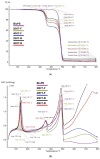Biocomposites of Bio-Polyethylene Reinforced with a Hydrothermal-Alkaline Sugarcane Bagasse Pulp and Coupled with a Bio-Based Compatibilizer
- PMID: 32380693
- PMCID: PMC7249044
- DOI: 10.3390/molecules25092158
Biocomposites of Bio-Polyethylene Reinforced with a Hydrothermal-Alkaline Sugarcane Bagasse Pulp and Coupled with a Bio-Based Compatibilizer
Abstract
Bio-polyethylene (BioPE, derived from sugarcane), sugarcane bagasse pulp, and two compatibilizers (fossil and bio-based), were used to manufacture biocomposite filaments for 3D printing. Biocomposite filaments were manufactured and characterized in detail, including measurement of water absorption, mechanical properties, thermal stability and decomposition temperature (thermo-gravimetric analysis (TGA)). Differential scanning calorimetry (DSC) was performed to measure the glass transition temperature (Tg). Scanning electron microscopy (SEM) was applied to assess the fracture area of the filaments after mechanical testing. Increases of up to 10% in water absorption were measured for the samples with 40 wt% fibers and the fossil compatibilizer. The mechanical properties were improved by increasing the fraction of bagasse fibers from 0% to 20% and 40%. The suitability of the biocomposite filaments was tested for 3D printing, and some shapes were printed as demonstrators. Importantly, in a cradle-to-gate life cycle analysis of the biocomposites, we demonstrated that replacing fossil compatibilizer with a bio-based compatibilizer contributes to a reduction in CO2-eq emissions, and an increase in CO2 capture, achieving a CO2-eq storage of 2.12 kg CO2 eq/kg for the biocomposite containing 40% bagasse fibers and 6% bio-based compatibilizer.
Keywords: 3D printing; bio-based filament; sugarcane bagasse pulp.
Conflict of interest statement
The authors declare no conflict of interest.
Figures








References
-
- Jakus A.E., Taylor S.L., Geisendorfer N.R., Dunand D.C. Metallic architectures from 3D-printed powder-based liquid inks. Adv. Funct. Mater. 2015:1–11. doi: 10.1002/adfm.201503921. - DOI
MeSH terms
Substances
Grants and funding
LinkOut - more resources
Full Text Sources
Miscellaneous

